STATEHOUSE REPORT | ISSUE 22.26 | June 30, 2023
BIG STORY: State releases big resilience plan to guide climate response
LOWCOUNTRY, Ariail: Happy Fourth of July!
COMMENTARY, Brack: Slow down, stop the tailgating and fix our roads
SPOTLIGHT: The S.C. Education Association
MYSTERY PHOTO: Rural home
FEEDBACK: Send us your thoughts
S.C. offers resilience plan to guide climate response

By Andy Brack | Despite naysayers who don’t believe the state’s climate is changing, state government has warmed to the idea that it needs to plan for future weather events that can change lives as quickly as flooding rips apart lives.
On Thursday, the state released a 708-page resiliency plan with 54 recommendations for it to grapple with future impacts of rising air temperatures, rising sea temperatures, more rain, more flooding and more devastating storms.
“This is a project that’s not going to begin today and end in a year or so,” Gov. Henry McMaster said during a Thursday press conference. “This is something that will be a permanent part of life in South Carolina.”
Implementing the recommendations won’t be cheap. In the 2023-24 budget, the state has reserved $200 million to boost resilience. Half of the recommendations in the report would cost $24 million in first-year costs, but the other half, including the possibility of a voluntary buyout program for homes in flood-prone areas, could cost billions.
What the future looks like

The plan outlines ways South Carolina can get ready for weather projections of hotter days, more rain, more storms and rising seas that people already are feeling. Among the carefully worded but key weather-related findings of the report that are likely to have a major impact on South Carolina’s future:
Temperature: South Carolina temperatures have gone up only about 1 degree since 1895, but “climate models project South Carolina temperature increases of 5 degrees to 10 degrees Fahrenheit by the year 2100, depending on future greenhouse gas emissions.”
Precipitation: The state’s rainfall varies, but summers have fewer rainy days and falls have more. “Rising temperatures in the 21st century will likely exacerbate agricultural and hydrologic drought.”
Storms: Because the state is vulnerable to hurricanes, “future scenarios … consistently project greater intensity of wind and precipitation for those storms that do occur.”
Sea-level rise: Because South Carolina’s coast is low-lying, it’s vulnerable to sea rise. Levels have risen by about 1 foot in recent years and could rise another foot by 2050.
Planning to deal with weather impacts
Those who wrote South Carolina’s resiliency plan used the following summary to guide its work: “[Resilience is] the ability of communities, economies and ecosystems within South Carolina to anticipate, absorb, recover and thrive when presented with environmental change and natural hazards.”
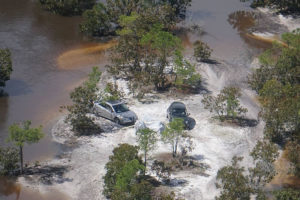
In a nutshell, areas with resilient infrastructure and other systems are able to anticipate and bounce back quicker than less reliant systems. But developing resiliency takes planning, money and time, experts say.
“You are correct in your emphasis on measures needed to build a robust, adaptive system, but time is not on your side,” writes Fred Palm, an Edisto Island resident who is a retired professor of oversight and investigations as well as a former executive director of the Association of Inspectors General. “Your plans will disappear in a flash in the next big storm.”
His comments, directed to S.C. Office of Resilience Planning Director Alex Butler, urged rapid deployment of the report’s recommendations: “Move like lightning on stuff you can implement, even if it is not so neat. Get real victories from the start.”
Palm also urged the state to make sure to educate local officials on the threat so they can beef up their resiliency efforts: “It is the elected officials that are sleepwalking and unwilling. The primary target of the education program needs to be the local councils. It is the county officials succumbing to the dream of growth that is corrupting the natural defenses” of South Carolina ecosystems.
Four score and six recommendations
According to the new report, it would cost $10.4 million a year plus $14 million in upfront or construction costs to implement 26 of the 54 recommendations. But those numbers are not indicative of the mammoth cost to boost resiliency as fully envisioned in the plan. Why? The voluntary pre-disaster buyout idea.
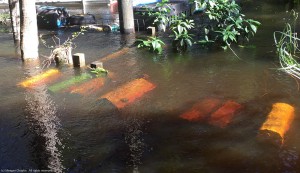
Establishment of a voluntary pre-disaster buyout program to “allow the state to be proactive rather than reactive to reduce the risk of future losses,” would cost billions. According to Appendix H of the plan, there are about 68,000 residential properties in flood hazard areas. They are worth $13.7 billion. In a voluntary buyout program, the state ideally would pay people for property and have them move from risky areas to reduce risks and improve resilience.
But Butler admitted during the Thursday conference that buyouts were a touchy subject, as reported by WCSC TV: “It’s a very delicate topic, right? It’s a very detailed topic to look at. There’s a lot of things to consider.
“There’s an attachment to place. Some folks have lived in communities for generations, and there’s a very strong attachment to place. So you have to work with the communities early on to let them know what you know and try to work to solutions that everybody can live with.”
Among nine other categories of recommendations in the report:
- Improve data collection and coordination. Examples: Get more weather stations (Palm suggests turning each school into a weather state and having it provide STEM education to students); do a state sediment study; analyze current zoning and land use policies statewide; and complete the state’s flood inundation modeling and mapping.
- Education outreach and disclosure. This includes having regional planning worships, developing a resilience training program and reestablishing a program for flood hazard signage.
- Watershed-based planning.
- Incorporating resilience concepts into planning and land use practices and processes.
- Maintaining and strengthening building codes.
- Incorporating resilience concepts into design, construction and maintenance of infrastructure.
- Promoting conservation of natural resources to maintain natural environmental protections.
- Incorporating resilience into housing, such as cutting use of manufactured housing units and boosting elevation standards.
- Identifying more funding sources.
For more information, read the plan here.
- Have a comment? Send to: feedback@charlestoncitypaper.com
Happy Fourth of July!
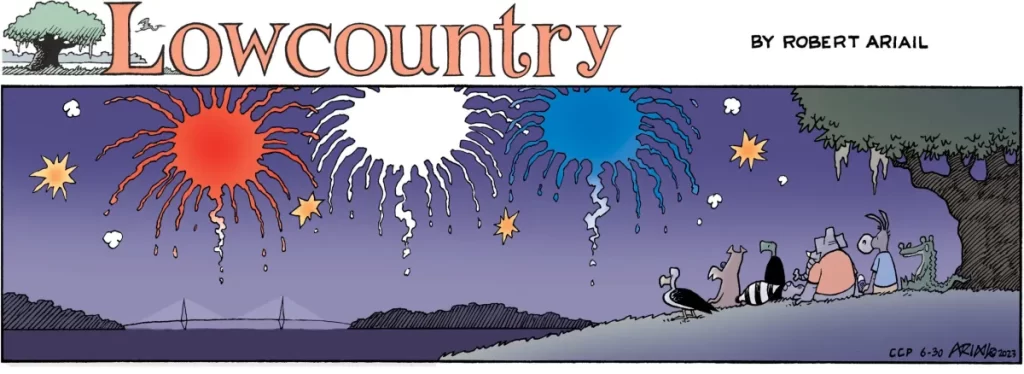
Cartoonist Robert Ariail generally has a biting or funny comment about the great state of South Carolina in his weekly cartoon. Not this week. He’s a kitty cat. Love the cartoon? Hate it? What do you think: feedback@statehousereport.com.
Slow down, stop the tailgating and fix our roads

By Andy Brack, editor and publisher | The S.C. Highway Patrol won’t officially confirm that the state’s roads are filled with more tailgaters, but all you have to do – at any time of day and any day of the week – is drive a little and it’s as clear as the nose on your face.
 All of a sudden as you’re cruising in the middle lane of an interstate at 70 mph, you glance in the rear-view mirror and suddenly you see some idiot who sneaked up on you and is just one or two car lengths behind your rear bumper. It’s not too long before he (yes, men are more aggressive drivers) yanks his cheap car to the right and passes, then cutting you off as he zips in front of you, only to pull up on some other car’s butt end.
All of a sudden as you’re cruising in the middle lane of an interstate at 70 mph, you glance in the rear-view mirror and suddenly you see some idiot who sneaked up on you and is just one or two car lengths behind your rear bumper. It’s not too long before he (yes, men are more aggressive drivers) yanks his cheap car to the right and passes, then cutting you off as he zips in front of you, only to pull up on some other car’s butt end.
“We do have a lot more tailgating and we have more aggressive driving in recent years,” observed state Sen. Larry Grooms, the Berkeley County Republican who chairs the state Senate Transportation Committee.
Tailgating is out of control. And there’s really not much you can do about it, as best as we can tell, because we have to rely on individual decisions of responsible driving to carry the day.
Creating a new law won’t directly stop tailgating and reckless driving, Grooms said. But he did note that with more cars on the roads, there’s more congestion.
“More traffic causes people to be frustrated and that causes people to have road rage and it causes people to drive aggressively.”
But driving more recklessly in heavy traffic isn’t a rational reaction and makes roadways more dangerous. So if you have some unsafe jerk crowding the tail end of your car, the best thing you can do is breathe deeply and pull over to let him get to wherever the hell he is in such a hurry to get to.
With the holiday approaching, it’s time to double-down on safety efforts by slowing down, backing off and being careful. AAA estimates that almost 750,000 people will be on South Carolina’s roads in coming days – an increase of about 10% from just four years ago.
Now, let’s address the real elephant in the room – South Carolina’s roads. Yes, the legislature raised the gas tax a few years ago to generate more money to fix roads and build some new ones. And a lot of the big work is being done at major interchanges in Greenville and Columbia. But everyday roads are a mess, needing multiple millions of dollars to fix everything from potholes to much worse.
For people who say you can’t just throw money at problems, you actually can when it comes to roads. Consider that Charleston County last year was happy to have enough money to resurface 25 miles of bad roads – in a county that has 4,000 lane miles of roads. It doesn’t take a mathematician to figure out that the next time those roads might get repaved under current conditions would be in 160 years.
Unfortunately, inadequate state funding for roads causes personal pain, too. As the Charleston City Paper reported last year in a story titled “Our roads suck,” drivers pay out of their own pockets to deal with roads. “Driving on deteriorated roads costs South Carolina motorists $1.7 billion a year — $439 per driver — in the form of additional repairs, accelerated vehicle depreciation, and increased fuel consumption and tire wear,” according to a 2022 report.
So yes, there’s something that the General Assembly can do to deal with tailgating, road rage, congestion and poor roads – spend more money to fix what we’ve got.
Award-winning columnist Andy Brack is editor and publisher of Statehouse Report and the Charleston City Paper. Have a comment? Send to: feedback@statehousereport.com.
The S.C. Education Association
 The public spiritedness of our underwriters allows us to bring Statehouse Report to you at no cost. This week’s spotlighted underwriter is The South Carolina Education Association(The SCEA), the professional association for educators in South Carolina. Educators from pre-K to 12th grade comprise The SCEA. The SCEA is the leading advocate for educational change in South Carolina. Educators in South Carolina look to The SCEA for assistance in every aspect of their professional life. From career planning as a student to retirement assessment as a career teacher, The SCEA offers assistance, guidance, and inspiration for educators.
The public spiritedness of our underwriters allows us to bring Statehouse Report to you at no cost. This week’s spotlighted underwriter is The South Carolina Education Association(The SCEA), the professional association for educators in South Carolina. Educators from pre-K to 12th grade comprise The SCEA. The SCEA is the leading advocate for educational change in South Carolina. Educators in South Carolina look to The SCEA for assistance in every aspect of their professional life. From career planning as a student to retirement assessment as a career teacher, The SCEA offers assistance, guidance, and inspiration for educators.
- Learn more: TheSCEA.org
Rural home
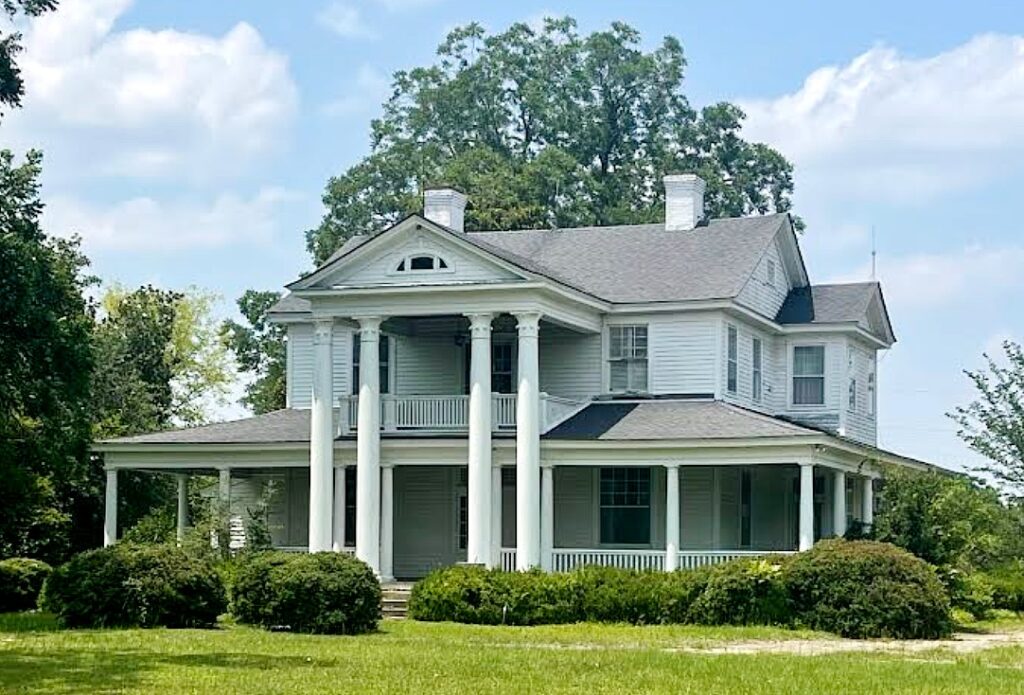
An avid reader sent in this mystery photo, which will pose a lot more head-scratching than last week’s easy mystery. Where is this house and why is it important? Send us your guess – as well as your name and hometown – to feedback@statehousereport.com.
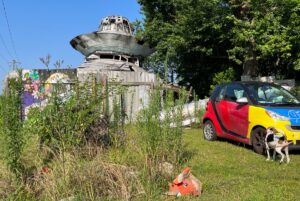 Woo boy – last week’s “Funky scene” got a lot of attention from older and new sleuths from around the state as more than two dozen people (the most ever) identified the quirky flying saucer UFO that’s an unofficial welcome center for the farming community of Bowman. We guess it wasn’t that much of a mystery, after all.
Woo boy – last week’s “Funky scene” got a lot of attention from older and new sleuths from around the state as more than two dozen people (the most ever) identified the quirky flying saucer UFO that’s an unofficial welcome center for the farming community of Bowman. We guess it wasn’t that much of a mystery, after all.
Elizabeth Jones of Columbia gave some context: “It actually was begun in 1994, built in the backyard of Jody Pendarvis. It’s a double-decker creation that’s 46-feet wide of wood, fiberglass and plastic. Pendarvis wanted to be an ambassador to the aliens and give them a familiar place to rest. The UFO is unorthodox, not scientific but built from materials handy and a lot of imagination. Tourists can see the UFO for $20 per person. Aliens tour for free.” [Editor’s Note: On a recent visit, it didn’t look like there was any visiting going on.]
Congratulations to these super-sleuths: George Graf of Palmyra, Va.; Barry Wingard and Jacie Godfrey, both of Florence; Bill Segars of Hartsville; Patsy Brison of Hilton Head Island; Allan Peel of San Antonio, Texas; Diane Peel of Rock Hill; Steve Willis of Lancaster; Anyeta Lary of Bowman; Lisa Griffin of Tega Cay; David Lupo of Mount Pleasant; Will Williams of Aiken; Jessica Jackson of Roseville; Pat Keadle of Wagener; Sheldawn Shuler of Reevesville; Bryan Hickman of Ruffin; Satoshi Bush Sr. and Lane Goodwin, both of Columbia; Jack Gramling of Orangeburg; Brittney Davenport of Honea Path; Mark Partin of Sumter; and Frank Bouknight of summerville.
Seven others answered correctly, but didn’t give their hometowns: Charles Ford, Holly Londergan, Jeannie Hughes, Debbie West, Lillie Clark, Dawn Desmond-Rast and Kay Bostick.
>> Send us a mystery picture. If you have a photo that you believe will stump readers, send it along (but make sure to tell us what it is because it may stump us too!) Send to: feedback@statehousereport.com and mark it as a photo submission. Thanks.
Send us your thoughts
We encourage you to send in your thoughts about policy and politics impacting South Carolina. We’ve gotten some letters in the last few weeks – some positive, others nasty. We print non-defamatory comments, but unless you provide your contact information – name and hometown, plus a phone number used only by us for verification – we can’t publish your thoughts.
- Have a comment? Send your letters or comments to: feedback@statehousereport.com. Make sure to provide your contact details (name, hometown and phone number for verification. Letters are limited to 150 words.
- ORDER NOW: Copies are in Lowcountry-area bookstores now, but if you can’t swing by, you can order a copy online today.
- Now available as an e-book!
ABOUT STATEHOUSE REPORT
Statehouse Report, founded in 2001 as a weekly legislative forecast that informs readers about what is going to happen in South Carolina politics and policy, is provided to you at no charge every Friday.
- Editor and publisher: Andy Brack, 843.670.3996
Donate today
We’re proud to offer Statehouse Report for free. For more than a dozen years, we’ve been the go-to place for insightful independent policy and political news and views in the Palmetto State. And we love it as much as you do.
But now, we can use your help. If you’ve been thinking of contributing to Statehouse Report over the years, now would be a great time to contribute as we deal with the crisis. In advance, thank you.
Buy the book
Now you can get a copy of editor and publisher Andy Brack’s We Can Do Better, South Carolina! ($14.99) as a paperback or as a Kindle book ($7.99). . The book of essays offers incisive commentaries by editor and publisher Andy Brack on the American South, the common good, vexing problems for the Palmetto State and interesting South Carolina leaders.
More
- Mailing address: Send inquiries by mail to: P.O. Box 21942, Charleston, SC 29413
- Subscriptions are free: Click to subscribe.
- We hope you’ll keep receiving the great news and information from Statehouse Report, but if you need to unsubscribe, go to the bottom of the weekly email issue and follow the instructions.
- Read our sister publication: Charleston City Paper (every Friday in print; Every day online)
- © 2023, Statehouse Report, a publication of City Paper Publishing, LLC. All rights reserved.















 We Can Do Better, South Carolina!
We Can Do Better, South Carolina!
Concerning your piece about tailgating, my experience here in Beaufort is that the driver that comes rushing up to your back bumper and then speeds around you is invariably a young women; Black White, Latina, doesn’t matter, they are almost always young women. I was stunned when this happened over and over because I usually associate this kind of aggressive behavior with young men. Also, how come there are many 3 or more lane interstate highways in SC while we remain the only state that still has 2 lane road on I-95?